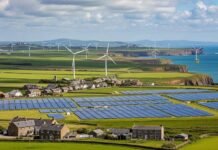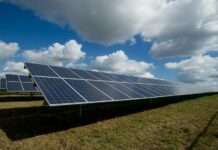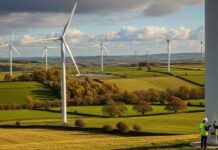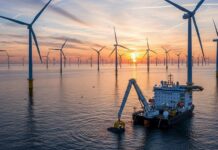In the pursuit of a greener future, individuals and businesses across the United Kingdom are striving to reduce their carbon footprint. One avenue towards achieving this goal is the electrification of various industries and the shift towards low-carbon electricity sources. However, an unexpected challenge has emerged on this path—the strain on the nation’s power grid.
Toddington Harper, the founder of Gridserve, a charging company specializing in electric vehicle chargers, faced this challenge head-on. Located in southwest England, near Bodmin in Cornwall, Harper’s service station needed innovative solutions to power its electric car chargers due to limited grid capacity. His answer was ingenious—a high-capacity battery combined with solar panels to alleviate the pressure on the local electricity distribution network. “It works incredibly well,” he remarked.
Yet, not all businesses have been as fortunate as Gridserve. Martin Smith, CEO of The Hex Group, a metals fabricator located near Stafford in the West Midlands, aimed to make his factory self-sufficient by installing solar panels. However, he encountered a significant roadblock: the local network operator demanded a substantial investment of up to £3 million to support grid improvements. Furthermore, he faced a daunting wait until 2032 to complete the installation of all the panels. Smith expressed his frustration, labeling the situation “absolutely scandalous.”
These examples underscore the growing challenges faced by privately owned power distribution networks across the UK as businesses adapt to the government’s mandate of achieving net-zero emissions by 2050. While the decarbonization of the economy is projected to double electricity consumption by 2050, the issues were initially concentrated on the supply side. New wind and solar farms struggled to connect and provide low-carbon electricity vital for achieving net-zero emissions. However, grid constraints are increasingly becoming a bottleneck on the demand side, where businesses require upgraded or new connections, leading to mounting delays.
Business associations have sounded the alarm, warning that these bottlenecks pose a threat to economic growth and could derail the decarbonization process. Shevaun Haviland, director-general of the British Chambers of Commerce, emphasized the importance of an efficient national grid and sufficient workforce to support growth. Haviland raised the issue with Chancellor Jeremy Hunt, recognizing its urgency. Catherine Cleary, a connections engineer at the grid consultancy Roadnight Taylor, reported lead times of eight to ten years for new or upgraded grid connections, further highlighting the growing challenge.
Industries seeking to decarbonize face a significant hurdle: the substantial increase in power demand when transitioning to low-carbon electricity to replace fossil fuels. For example, whisky distilleries switching to electric steam production may need to increase their grid capacity tenfold. Additionally, heavy industries like steel production are exploring electric arc furnaces as an alternative to coke in the iron ore smelting process. However, these furnaces consume massive amounts of power, equivalent to the annual energy needs of up to 200,000 homes, according to UK Steel.
British Steel, owned by China’s Jingye, plans to replace one of its coke blast furnaces with a less carbon-intensive electric arc furnace in Scunthorpe. Yet, securing a high-voltage grid connection has become a “significant hurdle” for the company to meet its emissions reduction target by 2035. British Steel is in discussions with the UK government regarding potential financial support for its decarbonization plans, recognizing the need for reform to keep pace with global advancements in green steel production.
Martin Mead, head of energy efficiency at DS Smith, revealed that even evaluating the switch to electricity for steam generation at their paper mills was challenging due to prohibitive national infrastructure. Steve Freeman, director of energy and environmental affairs at the Confederation of Paper Industries trade body, joined the call for government intervention to address grid reinforcement problems and costs.
Entrepreneurs like Toddington Harper, who are capitalizing on the electrification of the economy, have encountered similar challenges. Gridserve’s success in implementing innovative solutions highlights the importance of adaptability and innovation in the face of grid constraints.
The impact of grid limitations extends beyond individual businesses to industries vital for economic growth. Ceres, a London-listed fuel cell and electrolyser maker, had to cancel plans for a new technology center due to prohibitively long lead times of up to seven years for grid connections. Phil Caldwell, CEO of Ceres, emphasized the need for the right infrastructure to support high-growth companies. Tech UK, a trade group, echoed these concerns, stating that lengthy and costly grid connection processes hindered investments in facilities such as data centers and semiconductor factories.
Harper’s competitors in the electric vehicle charging industry also face delays in connecting new charge points, highlighting the widespread nature of the challenge. Ian Johnston, chair of ChargeUK, a trade group, labeled timely grid connections as “one of the biggest challenges faced by the sector.”
Recognizing the gravity of the situation, the Energy Networks Association, representing network owners, including FTSE 100 companies National Grid and SSE, expressed their determination to accelerate and improve the connection process. However, they noted that factors beyond their control, such as planning permission, also contributed to delays. The government acknowledged the need for action and pledged to work with regulators and network operators to reduce connection times. Nevertheless, given the scale of the challenge, a backlog in grid connections is expected to persist.
The strains on the UK’s power grid pose a significant challenge to the nation’s ambitious goals of achieving net-zero emissions by 2050. As businesses and industries seek to decarbonize and transition to low-carbon electricity sources, grid constraints on both the supply and demand sides have emerged as a bottleneck. Collaborative efforts between businesses, government, and network operators are essential to address these challenges and pave the way for a greener future.

































